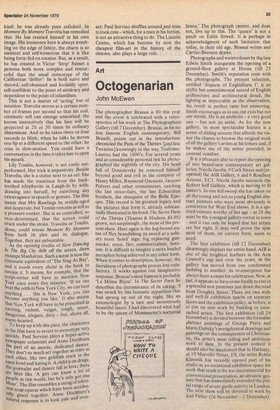Octogenarian
John McEwen
The photographer Brassai is 80 this year and the event is celebrated with a retrospective of his work at The Photographers Gallery (till 7 December). Brassai, as his no less famous English contemporary, Bill Brandt, points. out in the introduction, chronicled the Paris of the Thirties land late Twenties] knowingly in the way ToulouseLautrec had the 1890's. For several years and at considerable personal risk he photographed the nightlife of the city. His head full of Dostoievsky he removed himself beyond good and evil in the company of Henry Miller, Raymond Queneau, Jacques Prevert and other connoisseurs, catching the last street-fairs, the last Edwardian brothels, the obsequies of the Belle Epoque. This record is his greatest legacy and the pictures that form it, already substantially illustrated in his book The Secret Paris of the Thirties (Thames & Hudson, £4.95) prove, not surprisingly, the meat of the present show. Here again is the fog-bound statue of Ney brandishing its sword at a solitary neon 'hotel' sign: fog replacing gunsmoke; neon, fire; commercialism, heroism. It is difficult to imagine a more loaded metaphor being achieved in any other form. When it comes to description, however, the literalness of photographs proves less satisfactory. It works against our imaginative response. Brassai's most famous is probably 'La Menne Bijou'. In The Secret Paris he describes the circumstance of its taking: 'I was struck by this fantastic apparition that had sprung up out of the night, like an entomologist by a rare and monstrously beautiful insect. I had discovered what had to be the queen of Montmartre's nocturnal fauna.' The photograph cannot, and does not, live up to this. The 'queen' is not a patch on Edith Sitwell. It is perhaps in acknowledgment of such limitation that today, in their old age, Brassai writes and Cartier-Bresson draws.
Photographs and watercolours by the late Edwin Smith inaugurate the opening of a ground-floor gallery at House (till 23 December), Smith's reputation rests with the photographs. The present selection, entitled 'Aspects of Englishness l', is an idyllic but unsentimental record of English architecture and architectural detail, the lighting as impeccable as the observation, the result in perfect taste but unmoving. Smith encourages us to use our eyes but not our minds. He is an archivist — a very good one — but not an artist. As for the new gallery, its most spectacular feature is a series of sliding screens that affords the visitor the chance to browse the original work of all the gallery's artists at his leisure and, if he makes use of the settee provided, in unusual comfort.
It is a pleasure also to report the opening of two brand-new contemporary art galleries: Nicola Jacobs, 9 Cork Street and (reopened) the AIR Gallery, 6 and 8 Rosebery Avenue, EC1. Nicola Jacobs succeeds the Robert Self Gallery, which is moving to St James's. In one fell swoop she has taken on all the young and not so young English abstract painters who were most obviously in contention for West End shows. It is a spirited venture worthy of her age — at 20 she must be the youngest gallery-owner in town — and it can only be hoped that her artists see her right. It may well prove the spur most of them, on current form, seem to need.
The first exhibition (till 12 December) disarmingly displays her entire hand. AIR is o'ne of the brightest feathers in the Arts Council's cap and over the years, as the gallery has moved from one condemned building to another, its re-emergence has always been a cause for celebration. Now, at last, it appears to have come finally to rest in a splendid new premises just down the road from Doughty Street. There are two wide and well-lit exhibition spaces on separate floors and the exhibition policy, as before, is to put on new work by budding or unattached artists. The first exhibition (till 29 November) is divided between the formalist abstract paintings of George Perry and Mario Dubsky's metaphysical drawings and paintings on the consequences of Christianity, the artist's most telling and ambitious work to date. In the present context it should also be mentioned that in Hackney, at 10 Martell° Street, ES, the artist Robin Klassnik has recently opened part of his studio as an occasional exhibition space for work that tends to be too uncommercial for conventional presentation, an altruistic gesture that has immediately extended the pitiful range of avant-garde activity in London, The next show will be devoted to work by Joel Fisher (26 November 2 December),


































 Previous page
Previous page